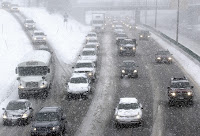Driving in Inclement Project Weather
This article was original posted on BetterProjects.net on February 22, 2010.
Some mornings you just wonder why you even get out of bed. A recent morning was no exception as my usual 45 minute commute stretched out to 1:45 minutes due to snow and ice. During those brief times I wasn’t in fear of my life from all the crazies out there with me, I started thinking about the reasons why so many people have problems driving in inclement weather. What lessons could my fellow motorists learn that would make all our commutes better during trying mornings like this one? As I thought down through the list, it occurred to me that many of the skills needed for driving in snow and ice are the exact same lessons many people working on projects should learn.
Rule 1 = Know the conditions on the road
As I listened to the radio while getting ready to leave the house, I heard that two counties in my region had called off school. Those two counties were in the opposite direction of my commute, so I thought I was fine. Ten minutes away from my house, I knew that was not the case. When I tried to exit the highway to get gas and the ramp was so slick most vehicles slid up it, I knew that it would be a long morning.
I wish that all highways and major thoroughfares had systems that reported icy conditions in addition to traffic reports. I would love to be able to open my iPhone’s Maps app and know immediately what my commute will be like. Sadly, that kind of information just isn’t available yet.
As project people, wouldn’t it be nice to know what mood our sponsor group is in prior to going into a meeting with them? There are definitely ways to gauge their mood and receptivity to ideas, but because we’re dealing with people, beliefs and opinions can change with rapid-fire intensity. Just like the road conditions significantly worsened 10 minutes away from my house, sponsor attitudes can change 10 minutes into a meeting.
Rule 2 = Keep the right amount of distance
We’ve heard it plenty of times before, but during inclement weather we need to leave extra space between our vehicles and that of the vehicles around us. Stopping is considerably more difficult in rain or snow and exponentially more difficult in ice. As I drove slowly up the single lane exit ramp that morning, people in four-wheel drive SUVs were trying to pass me on the shoulder. In icy conditions, four-wheel drives generally slide further than two-wheel drive vehicles due to the extra weight of a four-wheel drive system. Trying to pass in such conditions is a recipe for disaster.
In projects, its the same rule. Sometimes, when we have invested a great deal of our time, energy and life into a project, it is hard to see when we’ve lost our objectivity. When we fail to heed the warning signs that conditions have changed and continue to push ahead at the wrong times, we put our projects at greater risk.
On the other side of the subject, we can get too much distance. We have to be on top of our projects, knowing their ebb and flow. We can’t have so much space that we get distracted with other tasks. On the road, this causes us to relax and lose our sharp focus on the task at hand, potentially causing us to over-correct when we focus back in.
Rule 3 = Keep your wheels pointed in the right direction
When driving on ice, you’re going to slide. It is not a question of if, but when and how much. The best thing you can do when sliding is to not jerk the wheel around, but to point your wheels in the direction you want to go, so that when the slide stops, you’re pointed in the right direction.
Traction in projects is difficult to maintain, and icy patches, called conflicting priorities, often cause us to slide past where we want to be or slam into something we didn’t want to get so close to. Keeping our wheels going the right direction, even when our project vehicle is currently going somewhere else, ensures we’re ready to go when traction returns.
Rule 4 = Go the right speed (not too fast; not too slow)
There is a right speed for snow and ice. It is neither too fast nor too slow. Too fast and you will end up with your car in a ditch a few miles up the road, like the guy who passed me doing 65mph during my commute. Too slow and you’ll cause a pile-up of other people behind you who have to slam on their brakes to keep from running you over. It is a delicate balance to maintain, a complex dance if you will, but its absolutely essential.
Projects have the same dance. If we go too fast, we outpace the business areas we support and often our technical teammates. If we go to slow, we’re accused of holding up the project and costing the company money. We have to know the right speed for the conditions and match our speed appropriately.
To all our experienced project drivers out there, what tips do you have for navigating a rough-weather commute?
Image by Nicholas Lisi / The Post-Standard.

